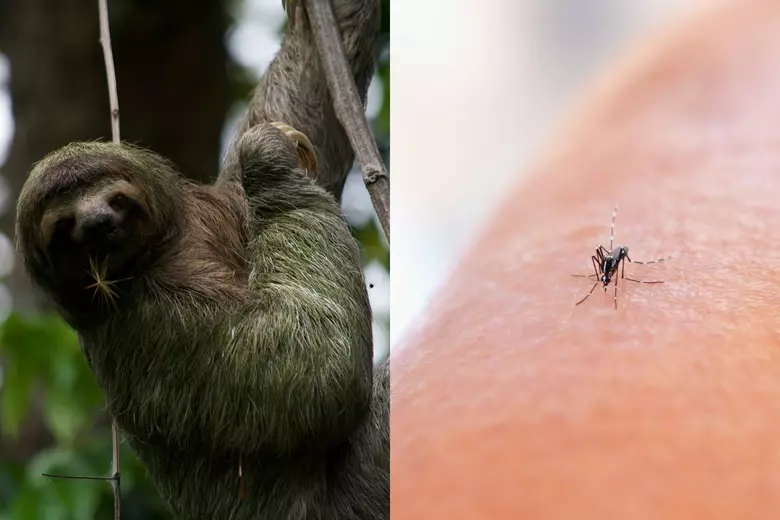Clearing Up the Confusion
In recent weeks, you may have come across alarming headlines about a so-called “sloth virus,” stirring up concerns about these gentle creatures. But before you start worrying about contracting a mysterious illness from a sloth, let’s set the record straight. The Sloth Conservation Foundation (SloCo) is here to clarify the situation and dispel the myths surrounding this misleading term.
The “Sloth Virus” – A Misleading Name
The virus in question is actually named Oropouche, and it has been causing a stir for all the wrong reasons. Contrary to what the headlines suggest, this virus is not exclusive to sloths. In fact, it has only been detected in a sloth once, way back in 1967. The real culprits? Primates like howler monkeys and marmosets, as well as various insects, are far more common carriers of this virus. So why is it suddenly being dubbed the “sloth virus”? Simply put, it’s a catchy term that grabs attention—but it’s not based on scientific fact.
What Is Oropouche Virus?
Let’s take a closer look at the Oropouche virus. This virus is transmitted to humans through bites from midges and mosquitoes, not from sloths. The name “sloth virus” seems to have been coined more for its sensational appeal than any actual connection to sloths. The most recent outbreaks of Oropouche virus have occurred in places like Cuba, where sloths don’t even live. So, linking this virus to sloths is not only misleading but also factually incorrect.
The 2016 Costa Rica Study: No Evidence of Oropouche in Sloths
Adding to the evidence against the “sloth virus” myth, a comprehensive study on sloth virology conducted in Costa Rica in 2016 found no trace of the Oropouche virus in sloths. This study should put to rest any lingering fears about sloths being significant carriers of this virus. The reality is that sloths are low-risk when it comes to transmitting diseases to humans, and labeling them as dangerous due to this virus is both unfair and inaccurate.
The Impact of Misleading Information
Sloths have long struggled with a bad reputation, often unjustly labeled as dirty, dangerous, and disease-ridden. This negative image has led to widespread mistreatment and neglect of these animals. It’s only in recent years, thanks to extensive education and awareness campaigns, that public perception has started to shift. People are beginning to recognize sloths as the gentle, slow-moving creatures they truly are, and not the disease carriers they were once thought to be.
However, misleading terms like “sloth virus” threaten to undo this progress. When people believe an animal is dangerous or unclean, they’re less likely to support conservation efforts. This can have serious consequences for sloths, whose habitats are already under threat from deforestation and human encroachment.
The Role of Media in Spreading Misinformation
The Sloth Conservation Foundation urges media outlets to exercise caution and responsibility when reporting on such matters. Sensational headlines might grab clicks, but they can also cause unnecessary fear and harm to conservation efforts. It’s crucial that the media use scientifically accurate terminology to prevent the spread of misinformation.
Misleading headlines not only alarm the public but also divert attention from the real issues at hand—protecting species that are genuinely at risk. By focusing on non-existent threats, we risk neglecting the conservation work that’s desperately needed to preserve sloths and other wildlife.
SloCo’s Commitment to Conservation and Education
At the Sloth Conservation Foundation, our mission remains clear: to protect sloths and their habitats through research, conservation, and public education. We are committed to spreading accurate information and combating the myths that harm these beloved creatures. Sloths are a vital part of our ecosystem, and it’s our duty to ensure they can thrive in the wild.
We encourage the public to seek information from reliable sources and to support efforts that help protect sloths and other wildlife. If you’re concerned about wildlife and disease, remember that the best defense is a well-informed public, not sensational headlines.
The Real Story Behind the “Sloth Virus”
So, is there really a “sloth virus” that you need to worry about? The short answer is no. The term is a misnomer that has little to do with the facts. The Oropouche virus, while real, is not something that sloths are spreading. In fact, the connection between sloths and this virus is so tenuous that it’s almost laughable—if it weren’t for the potential harm such misinformation can cause to conservation efforts.
Let’s not let catchy headlines derail the important work being done to protect sloths. By staying informed and supporting organizations like the Sloth Conservation Foundation, we can ensure that these gentle creatures continue to be a treasured part of our world.
For more information and to get involved in sloth conservation, visit the Sloth Conservation Foundation’s website or contact us directly. Together, we can make a difference.
Contact: Dr. Rebecca Cliffe
Email: contact@slothconservation.org
The Sloth Conservation Foundation
Website: www.slothconservation.org

